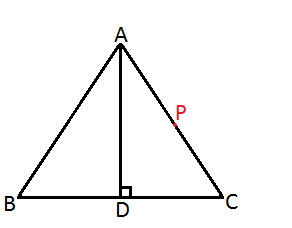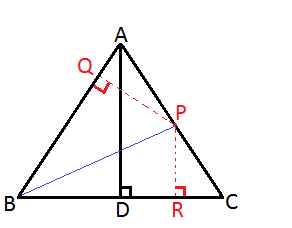Moving Dot in a Line Segment

There is a moving dot P on A C ,the line segment in equilateral △ A B C . The sum of the distance from P to A B and the distance from P to B C is the value a ,and the length of A D is the value b . What is the quantitative relationship between a and b ?
This section requires Javascript.
You are seeing this because something didn't load right. We suggest you, (a) try
refreshing the page, (b) enabling javascript if it is disabled on your browser and,
finally, (c)
loading the
non-javascript version of this page
. We're sorry about the hassle.
1 solution
 Because of the equilateral
△
A
B
C
,we can suppose that
A
B
=
B
C
=
A
C
=
x
.
Find the dot
Q
on
A
B
such that
P
Q
⊥
A
B
and find the dot
R
on
B
C
such that
P
R
⊥
B
C
.The value
a
is equal to the sum of the length of
P
Q
and the length of
P
R
.Then
S
△
A
B
C
=
S
△
P
A
B
+
S
△
P
B
C
=
2
1
A
B
×
P
Q
+
2
1
B
C
×
P
R
=
a
x
.
And
S
△
A
B
C
is also equal to
2
1
A
D
×
B
C
=
b
x
.
Therefore
2
1
a
x
=
2
1
b
x
,
a
=
b
.
Because of the equilateral
△
A
B
C
,we can suppose that
A
B
=
B
C
=
A
C
=
x
.
Find the dot
Q
on
A
B
such that
P
Q
⊥
A
B
and find the dot
R
on
B
C
such that
P
R
⊥
B
C
.The value
a
is equal to the sum of the length of
P
Q
and the length of
P
R
.Then
S
△
A
B
C
=
S
△
P
A
B
+
S
△
P
B
C
=
2
1
A
B
×
P
Q
+
2
1
B
C
×
P
R
=
a
x
.
And
S
△
A
B
C
is also equal to
2
1
A
D
×
B
C
=
b
x
.
Therefore
2
1
a
x
=
2
1
b
x
,
a
=
b
.
The sum of the distance from P to A B and the distance from P to B C is the value a